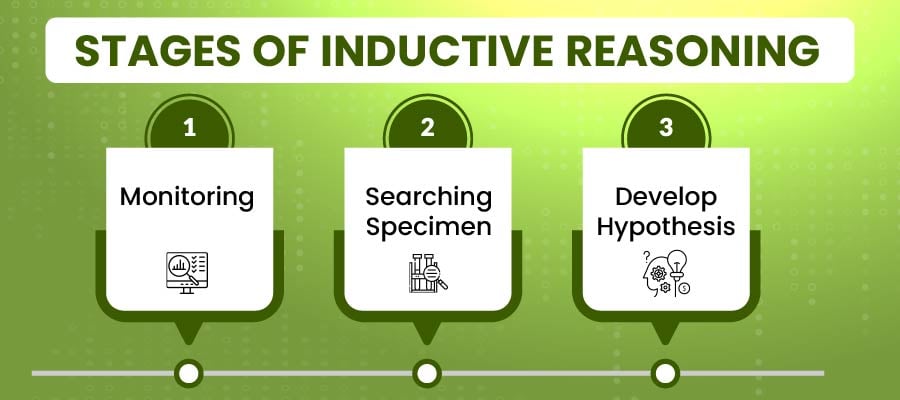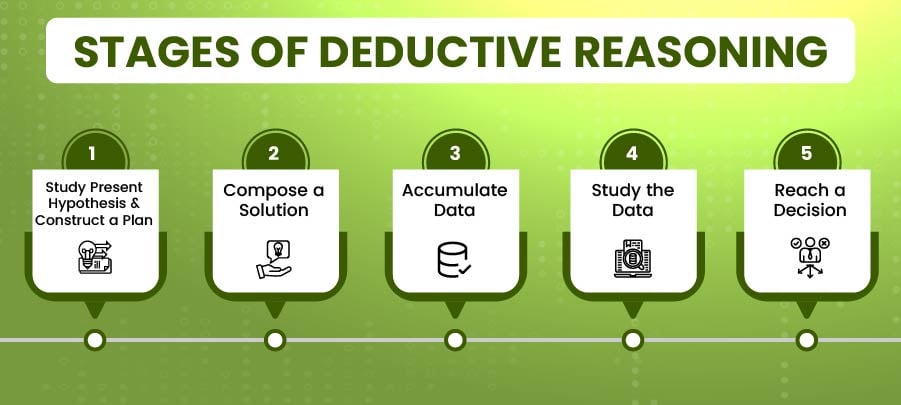 Offers
New
Order Now
Offers
New
Order Now
It is not an easy task to write an academic paper. It takes a lot of grit to compose a paper of a scholarly level, as it takes many hours and extensive research. You must make every possible effort to better yourself, as only then will your paper be published.
In this blog, you will learn the meaning, limitations, use, and examples of inductive vs deductive reasoning. It will help you to conduct better research for your paper where this technique can be used. So, without any delay, let us see how you can better your writing with the application of this method.
Inductive reasoning is also known as inductive logic or conclusion. It is an approach that moves from the bottom to the top. In this approach, you use specific and limited observations to reach general conclusions that can be used to apply more widely. It is the total opposite of deductive reasoning.
Some outcomes might not be possible, but you get various options. This theory provides a starting point, which is vital to any approach. It tests the existing inference and fuels more possibilities. Moreover, it tests whether the observation made and the conclusion reached are correct or not. It will be clear to you when you see inductive reasoning examples in the upcoming heading.
This theory provides that anyone using this technique explores a context and comes up with various scenarios. As many options, they can find out whether the conclusions are true or not.

Monitoring- Marking that in one specific situation, one fact is true
Searching Specimen- Looking for more situations where this fact is true.
Develop Hypothesis- Concluding that a specific fact is true in particular situations
So, you saw what the inductive research approach is. Now, under this heading, we will see the limitations of this approach and where to use it.
Inductive reasoning begins with a single observation that is extracted from a particular and comparable situation. Therefore, it is very likely that getting an on-point inference might not reap diversity.
Get Top-Notch Research PapersIt climbs from something p[particular and later tries to generalize it that which might not be accurate. The logic is great, but the outcome can be flawed.
You can use this approach to make routine decisions. It is most commonly used in scientific fields where data is already available, and you draw conclusions from it.
Its foundation relies on proof to support its premises. It is most suitable for areas with limited data. It helps you to draw results by using probabilities. Arguments drenched in law, rules, and other usually common beliefs are best expressed deductively.
You saw the meaning of this word and the limits and usage of this approach. If you are having any issues with the usage of correct grammar or spelling, you can seek a grammar checker.
Deductive reasoning is the complete opposite of inductive reasoning. In this approach, you use a general concept or premise as a foundation to conclude. This type of reasoning usually leads to results as you already know the background to be correct. It is one of the huge differences between inductive and deductive reasoning.
So, this means you reach a sensible conclusion using a reasonable assumption. You can build theories and theses on the information that is already present, along with rules. So, the tests conducted will see whether the principles will apply to a certain case or not.
You start this reasoning within a first premise that precedes another premise and inference based on proof and logic. The most common form of this approach is the syllogism.
In the two statements, a major and minor premise, and together, they conclude. In this reasoning, if a particular thing is true of a class of things, it means all the things in that class of things are true.

Study Present Hypothesis and Construct a Plan- You study the present situation available at hand and according to it draw an inference.
Compose a Solution- Once you draw an inference, now you come up with a plan.
Accumulate Data- Once you made a plan, now you collect data in accordance to inference drawn.
Study the Data- As the title suggests, you compare and analyze the data.
Reach a Decision- On the basis of the analysis drawn, you reach a conducive decision.
Deductive reasoning can be inaccurate. If the foundation is faulty, the conclusion that you will reach will also be incorrect.
Another drawback of this approach is that it can be very time-consuming. Comping up with a valid argument and checking all the options can be quite time-consuming, which results in inflexibility and rigidity. People who rely on this technique can be too straight-jacketed, refusing to appreciate other people's points of view.
Deductive reasoning can be utilized in different facets of life. For illustration, you can use this logic in problem-solving, confirming an authentic belief and using it as a footing for a dependable solution. It lessens guesswork and results in rarer fallacies.
This method is used in the consumer service venture. Deductive reasoning aids you in choosing a suitable solution to a client problem by pinpointing what makes them sad and connecting it to what you understand about their incident. Ultimately, this helps manage customer crises and boost their delight.
So, you saw what deductive reasoning is, its limitations, and where it can be applied. It is a more open approach than inductive reasoning and will provide more accurate solutions. You can use this approach how to write a good hypothesis, as it requires you to analyze a large amount of information to reach a valid conclusion.
In this heading, you will see some examples of the inductive vs deductive reasoning. It will assist you to furnish a more complete idea about how to apply these techniques to real-life situations. You must pay particular attention to it, so you can get a sounder idea about it. It will allow you to understand the definition and its application more correctly.
It takes specific data and makes a broader generalization.
I have noticed the traffic is worse between 9 am to 11 am. So, I will go to the temple after 11 am.
In this instance, the person has noticed that the traffic is worst between 9 and 11 in the morning. This generalization will help people to make an informed decision. While it is not concrete, it is likely that the traffic will be better between 10:30 and 11
My dad is Spanish and has brown hair and green eyes. It means all Spanish people must have brown hair and blue eyes.
In this instance, the person is basing a fact on a single isolated case and drawing a conclusion. It will not reap accurate results, as the color of people's eyes and hair can differ based on the region from where a person comes.
It takes general data and reaches a specific conclusion.
All students eat burgers. Samuel is a student at NYU. That means he also eats burgers.
In this instance, the person has noticed all the students eat burgers, which means Samuel also eats burgers. It will reap accurate results as it has drawn consensus from broad data.
The note is green in color, is made of paper, and has the president's photo on it then the note in my pocket also has all these qualities.
In this instance, a conclusion has been reached that the note in the person's pocket has attributes like green color, made of paper, and has the president's photo on it. All the notes have the same features. It is a concrete result because it is drawn from a wide variety.
Therefore, you saw the difference between inductive and deductive reasoning with the help of examples.
So, you saw the meaning, examples, limitations, and uses of inductive vs deductive reasoning. It will help you to understand and apply it to real-life situations. You must follow the rules and regulations provided in this concept if you want to benefit from the results successfully.
If you still have issues writing a paper on this topic, you can seek global assignment help Australia for help. You are guaranteed a flawless document with no mistakes and errors, as the experts at our disposal have a lot of experience working in this field for a long time.
FAQ'S
What Are the Limitations of Inductive Reasoning?
The limitation of inductive reasoning is that the result that you reach may not be accurate at all times. There will be no diversity in the outcome of an analysis.
What Are the Limitations of Deductive Reasoning?
Even though the results under deductive reasoning are accurate, the process is time-consuming. It takes a lot of time to conclude a hypothesis.
What Is the Law of Inductive Reasoning?
The law of inductive reasoning is that it builds its theory regarding a general rule from the proof available and then sees whether it contradicts or supports the theory.
What Is the Law of Deductive Reasoning?
The law of deductive reasoning is that it builds its theory regarding large data from the proof available and then sees whether the conclusion is true or false.

Grab this exclusive offer and start your journey to savings today! Act quickly, as this special offer won't be around for long!

This blog explains what is a hyperbole, provides engaging examples, & explores how to use hyperbole.

Explore 150+ funny debate topics to spark laughter, creativity, and lively discussions in 2025

Cross-Sectional Study basics explained with steps, examples, and comparisons.
Limited Time Offer
Exclusive Library Membership + FREE Wallet Balance
1 Month Access !
5000 Student Samples
+10,000 Answers by Experts
Get $300 Now
Update your Number

